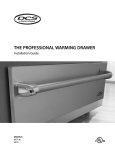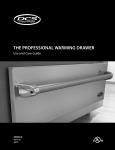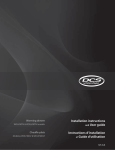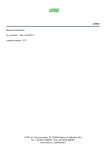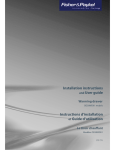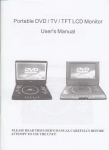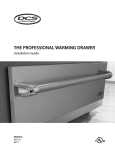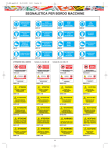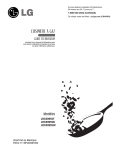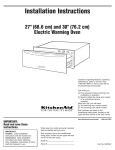Download DCS Warming Drawer WDI User guide
Transcript
Professional Outdoor Warming Drawer WD1-30-SSOD models Professional extérieur réchauffement tiroir Modèles WD1-30-SSOD Installation instructions and User guide Instructions d’installation et Guide d’utilisation US CA A MESSAGE TO OUR CUSTOMERS Thank you for selecting this DCS Outdoor Warming Drawer. Because of its unique features, we have developed this Use and Care and Installation Guide. It contains valuable information on how to properly operate, install and maintain your new Warming Drawer for years of safe and enjoyable use. To help serve you better, please fill out and submit your Ownership Registration by visiting our website at www. dcsappliances.com and selecting “Customer Service” on the home page and then select “Ownership Registration”. You may also submit the enclosed Ownership Registration Card by mailing it to the address below. In addition, keep this guide handy, as it will help answer questions that may arise as you use your new DCS Warming Drawer. For your convenience, product questions can be answered by a DCS Customer Care Representative by phone: 1-888-936-7872, email: [email protected], or by mail: Fisher & Paykel Appliances Inc. Attention: DCS Customer Care 695 Town Center Drive, Suite 180 Costa Mesa. CA 92626-1902 USA email: [email protected] NOTE: Please write the Model and Serial Number on this page for references (See page 6 for location of Model and Serial Number.) MODEL NUMBER SERIAL NUMBER WARNING The warming drawer is not intended to be used in conjunction with water. DO NOT fill the drawer or warming cavity with water. Doing so could create a shock hazard, resulting in possible injury. WARNING TO REDUCE THE RISK OF INJURY TO PERSONS IN THE EVENT OF A WARMING DRAWER GREASE FIRE, OBSERVE THE FOLLOWING: SMOTHER FLAMES with a close-fitting lid, cookie sheet, or metal tray, then turn off the unit. BE CAREFUL TO PREVENT BURNS. If the flames do not go out immediately EVACUATE AND CALL THE FIRE DEPARTMENT. NEVER PICK UP A FLAMING PAN - You may be burned. DO NOT USE WATER, including wet dishcloths or towels - a violent steam explosion will result. Use an extinguisher ONLY if: 1. You know you have a Class ABC extinguisher, and you already know how to operate it. 2. The fire is small and contained in the area where it started. 3. The fire department is being called. 4. You can fight the fire with your back to an exit. WARNING DO NOT use water on grease fires. Turn OFF the warming drawer, then smother the fire with b aking soda or use a dry chemical or foam-type fire extinguisher. PLEASE RETAIN THIS MANUAL FOR FUTURE REFERENCE. 1 TABLE OF CONTENTS SAFETY PRACTICES & PRECAUTIONS 3-5 WARMING DRAWER FEATURES 6 INSTALLATION Specifications7 Cutout Dimensions 7 Mounting Installation 10-11 USE AND CARE INFORMATION Operational Guide Cleaning the Warming Drawer Removing the Drawer Replacing the Drawer 12 13 14 15 SUGGESTED TEMPERATURE SETTINGS TO KEEP FOODS HOT 16 WIRING DIAGRAM 17 SERVICE18 2 SAFETY PRACTICES & PRECAUTIONS READ AND UNDERSTAND THESE PRECAUTIONS n Read this Use and Care and Installation Manual thoroughly before using your new appliance. This will help to reduce the risk of fire, electric shock, or injury to persons. n Remove all packaging materials from your appliance. n Install according to instructions. To insure proper installation and servicing, follow the installation guide which came with this appliance. n Be sure to have a qualified service technician install and ground this appliance. n Plug into rated outlet: 120 Volts AC, 15 amp GFI (Ground Fault Interrupt) circuit requirement. WARNING To reduce the risk of electric shock and fire, do not use an extension cord with this appliance. FOR OUT DOOR INSTALLATION, INSTALLER MUST INSTALL A GROUND FAULT INTERRUPT (GFI). WARNING n The installer should leave these instructions with the consumer who should retain for local inspector’s use and for future reference. n This appliance is not fused. Protect with a proper sized fuse or circuit breaker and a GFI for outdoor models. n Line disconnect switch, circuit breaker, GFI (for outdoor models) or plug/receptacle of power cord connection should be readily accessible to the operator. n Ground unit per applicable electrical codes. n Any installation not matching the specifications discussed in these instructions will void the manufacturer’s war- ranty. n Children should not be left alone or unattended in an area where appliances are in use. They should never be al- lowed to turn knobs, push buttons, sit or stand on any part of an appliance. n Children in walkers, or children crawling can be attracted to the round door handle and may grab and open the warming drawer. This can result in injury from the door being pulled open on a child, or severe burns if it is in use and hot. WARNING Do not store items of interest to children in, above or around any appliance. Children could be seriously injured if they should climb onto the appliance to reach these items. Be certain to use only dry pot holders: Moist or damp pot holders on hot surfaces may cause burns from steam. Do not use a towel or other bulky cloth in place of pot holders. n Never store anything in the warming drawer. Flammable materials can catch fire, plastic items may melt or ig- nite and other types of items could be ruined. n Do not hang articles from any part of the appliance or place anything against the drawer. Some fabrics are quite flammable and could catch on fire. 3 SAFETY PRACTICES & PRECAUTIONS n For safety reasons and to avoid damage to the appliance, never sit, stand, or lean on the warming drawer door. n For personal safety, wear proper apparel. Loose fitting garments or hanging sleeves should never be worn while using this appliance. Some synthetic fabrics are highly flammable and should not be worn while using this appliance. n Do not use aluminum foil to line any part of the warming drawer. Using a foil liner could result in a fire hazard, or the obstruction of the flow of heat and ventilation air. Foil is an excellent heat insulator and heat will be trapped underneath it. This trapped heat can upset the p erform ance of the warming drawer parts. WARNING This appliance is designed for keeping food warm. Based on safety considerations, never use the warming drawer to warm or heat a room. n As with any cooking appliance, never leave the warming drawer unattended when in use. This could be a fire hazard. n Only certain types of glass, heat proof glass-ceramic, ceramic, earthenware or glazes are suitable for use in this warming drawer. Utensils that are not thermally heat safe may break with sudden temperature changes. n Never heat unopened containers, a build up of pressure may cause the container to burst. n 120 volt AC, 15 amp GFI circuit required. n Grease is flammable, avoid letting grease deposits collect in the warming drawer, clean up spillage. n DO NOT use water on grease fires. Turn OFF the warming drawer, then smother the fire with b aking soda or use a dry chemical or foam-type fire extinguisher. n When opening the drawer while keeping liquids like soups and sauces, the drawer must be opened slowly to avoid spillage. n Use care when opening a hot warming drawer. To avoid severe burns, open slowly and allow the hot air or steam to escape before reaching into the warming drawer to remove or replace any foods. n Do not repair or replace any part of this appliance unless it is specifically recommended in this manual. All other servicing should be referred to a qualified S ervice Technician. Service Technicians must disconnect the power supply before s ervicing this appliance. n When using the warming drawer: To avoid burn injuries, DO NOT TOUCH THE INTERIOR SURFACES or the exterior area immediately surrounding the door until it has had sufficient time to cool. n Clean the warming drawer with caution. Avoid steam burns; do not use a wet sponge or cloth to clean the appli- ance while it is hot. Some cleaners produce noxious fumes if applied to a hot surface. Follow directions provided by the cleaner m anufacturer. n Be sure all the c ontrols are turned off and the appliance is cool before using any type of aerosol cleaner on or around the appliance. The chemical that produces the spraying action could, in the presence of heat, ignite or cause metal parts to corrode. n Use caution when touching the heating element (even if it is dark in color) and the interior surfaces of the warm- ing drawer. n Do not allow flammable materials which may ignite to come in contact with the hot heating element or the inte- rior surface of the warming drawer until the unit has had a sufficient time to cool. 4 IMPORTANT SAFEGUARDS SAVE THESE INSTRUCTIONS n Read all instructions n Do not touch hot surfaces. Use handles or knobs. n To protect against electrical shock, do not immerse cord, plugs, or element in water or other liquid. n Close supervision is necessary when any appliance is used by or near children. n Unplug from outlet when not in use and before cleaning. Allow to cool before putting on or taking off parts. n Do not operate any appliance with a damaged cord or plug or after the appliance malfunctions or has been dam- aged in any manner. Return appliance to the nearest authorized service facility for examination, repair, or adjustment. n The use of accessory attachments not recommended by the appliance manufacturer may cause injuries. n Do not let cord hang over edge of table or counter, or touch hot surfaces. n Do not place on or near a hot gas or electric burner, or in a heated oven. n Extreme caution must be used when moving an appliance containing hot oil or other hot liquids. n Always attach plug to appliance first, then plug cord into the wall outlet. To disconnect, turn any control to “off”, then remove plug from wall outlet. n Do not use appliance for other than intended use. n Save these instructions. n Use only on properly grounded outlet. n To reduce the risk of fire, do not place any heating or cooking appliance beneath the appliance. n To reduce the risk of fire, do not mount unit over or near any portion of a heating or cooking appliance. n To reduce the risk of electric shock, do not mount over a sink. n To reduce the risk of fire, do not store anything directly on top of the appliance surface when the appliance is in operation. 5 WARMING DRAWER FEATURES Stainless Steel Tray Power Indicator Lens Power Indicator Light Thermostat Control Knob Model and serial tag Stainless Steel Drawer Fig. 01 6 INSTALLATION INSTRUCTIONS PROUD INSTALLATION SPECIFICATIONS 2-1/2” min. to bottom of countertop A 120 Volt AC The cabinet depth from the outer edge of the face frame to the inside back of the cabinet or(GFI) wall should be at outlet should be located below the least 24 3/16” inches (see figure 02A). 14-7/16" (367mm) Warming Drawer The Warming Drawer should be installed into a base cabinet with minimum outside dimensions of 18 1/2” high by 31” wide by 24 3/16” deep (see figures 03A & 04A). 2x4’s or similar support Power supply required: 120 VAC; 15 amp GFI (Ground Fault Interrupt) circuit CUTOUT DIMENSIONS 28 3/8" (720mm) 24 3/16” (614mm) min. cabinet depth 28 3/8" (720mm) 2-1/2” min. to bottom of countertop 14-7/16" (367mm) PROUD 1 7/8" (47mm) 1 7/8" (47mm) 2x4’s or similar support 28 3/8" (720mm) 21 1/8" (537mm) 24 3/16” (614mm) min. cabinet depth 28 3/8" (720mm) Position supporting boards as shown so product can be secured into position. 30” Fig. 02A PROUD 23 1/4” (590mm) 1 7/8" (47mm) 14-7/16" (367mm) 1 7/8" (47mm) 16” 14-7/16" (367mm) A 120 Volt AC (GFI) outlet should be located below the Warming Drawer 27 1/4” (692mm) 26 1/8” (663mm) 24 1/8” (613mm) 21 1/8" (537mm) Position supporting boards as shown so product can be secured into position. Electrical outlet 11-11/16” (297mm) 16” Drain 30” 1”(25mm) Fig. 03A 23 1/4” (590mm) 26 1/8” (663mm) 24 1/8” (613mm) 1 -5/8” (41mm) 13/16” (20mm) 12-1/4” (311mm) Fig. 04A 27 1/4” (692mm) 7 Installed bracket 14 -7/16” (367mm) INSTALLATION INSTRUCTIONS FLUSH INSTALLATION SPECIFICATIONS 2-1/2” min. to bottom of countertop 120 Volt AC (GFI) The cabinet depth from the outer edge of the face frame to the inside back of theAoutlet cabinet or wall should be at should be located below the least 26 3/16” inches (see figure 02B). 16 3/16" (411mm) Warming Drawer The Warming Drawer should be installed into a base cabinet with minimum outside dimensions of 18 1/2” high by 31” wide by 26 3/16 deep (see figures 03B & 04B). 2x4’s or similar support Power supply required: 120 VAC; 15 amp GFI (Ground Fault Interrupt) circuit CUTOUT DIMENSIONS 30 3/16" (766mm) 26 3/16" (664mm) min. cabinet depth 30 3/16" (766mm) 2-1/2” min. to bottom of countertop 16 3/16" (411mm) FLUSH 2 3/4" (70mm) 2 3/4" (70mm) 2x4’s or similar support 30 3/16" (766mm) 21 1/8" (537mm) 26 3/16" (664mm) min. cabinet depth 30 3/16" (766mm) Position supporting boards as shown so product can be secured into position. 30” Fig. 02B FLUSH 23 1/4” (590mm) 2 3/4" (70mm) 16 3/16" (411mm) 2 3/4" (70mm) 16” 16 3/16" (411mm) A 120 Volt AC (GFI) outlet should be located below the Warming Drawer 27 1/4” (692mm) 26 1/8” (663mm) 24 1/8” (613mm) 21 1/8" (537mm) Position supporting boards as shown so product can be secured into position. Electrical outlet 11-11/16” (297mm) 16” Installed bracket Drain 30” 1”(25mm) 13/16” (20mm) 1 -5/8” (41mm) 12-1/4” (311mm) Fig. 03B Fig. 04B 23 1/4” (590mm) 27 1/4” (692mm) 26 1/8” (663mm) 24 1/8” (613mm) 8 14 -7/16” (367mm) INSTALLATION INSTRUCTIONS FLUSH INSTALLATION A frame should be constructed 2 ” (51mm) setback from the front face of the product to both push the product up against and to conceal the cutout clearance around the front frame as below. The internal dimensions of the frame should be the same dimension as the proud installation cutout (fig 02A). 3/16” (4mm) 1/16" (2mm) 2" x 4" (or similar) 1/16" (2mm) FLUSH 2" x 4" (or similar) Minimum 3/16” (4mm) cutout clearance around the front frame 2 5/8” (67mm) SECTION FLUSH MOUNT WARNING Do not seal the product in with silicone or similar. Doing so will result in the product being difficult to remove for servicing. 9 INSTALLATION INSTRUCTIONS MOUNTING INSTALLATION The lower rear corners of the cabinet need to provide proper support to the back of the Warming Drawer and the anti-tip mounting clips. A 120 volt AC 15 amp (GFI) outlet should be located no further than 36 inches from the back center of the Warming Drawer. Illustrations suggest one possible bottom support, but the consumer is not limited to this idea for mounting configuration. STEP 1 The bottom rear section of the cabinet should be made of moisture protected lumber and needs to be installed to hold the anti-tip mounting clips and support the weight of Warming Drawer, which is 90 lbs. A pair of supports located as shown on the previous pages is recommended to allow water to drain from drawer once installed. STEP 2 Use the screws provided to attach the mounting clips which must be installed for anti-tip safety to the bottom support at the back. See placement dimensions in Fig. 05 and Fig. 06. STEP 3 The Warming Drawer has slots on the back side where it will slide onto the anti-tip mounting clips. Plug power cord into the AC outlet. See figure 06. STEP 4 Fasten the front face to the cabinet by passing the screws through the 2 holes of the front face of the warming drawer to finish the installation. See figure 07. OTE: The bottom support made of moisture protected lumbar runners or other moisture proN tected construction must be capable of supporting the weight of the warming drawer. A drain hole MUST be provided for drainage. 21 3/8" (proud installation) or 23 3/8" (flush installation). Slide drawer on to Anti-Tip mounting clips mounting clips Fig. 05 10 mounting clips INSTALLATION INSTRUCTIONS Center line to Center line for mounting clips 21 1/8" (536mm) Fig. 06 p ps ps Fig. 07 11 USE & CARE INFORMATION OPERATIONAL GUIDE The Warming Drawer is designed to keep previously cooked foods at a safe, warm temperature, for extended periods of time, when operated correctly. It is not designed to cook or reheat food. The Warming Drawer should be pre-heated on HIGH according to the chart below prior to inserting the food to be warmed. Food may be kept up to two hours in the warming drawer. Failure to pre-heat could result in unsafe food temperatures, which could accelerate the formation of bacteria in the food being kept warm. The dial on the top right corner of the unit is the on/off and temperature control adjustment. After preheat, when the dial is turned clockwise from the OFF position to the LOW position, the unit will maintain a temperature of approximately 175°F. By rotating the dial clockwise to the HIGH position, the drawer will reach a temperature of approximately 230°F. Fig. 08 TO USE: TURN THE THERMOSTAT DIAL TO A TEMPERATURE SETTING: HIGH MEDIUM LOW n If you will be using the tray, preheat it while preheating the warming drawer. n Preheat any empty serving dishes to be used, while preheating the drawer. n Add cooked, hot food in its cooking container or heat-safe container. n Aluminum foil may be used to cover food containers. CAUTION Do not use plastic containers or plastic wrap. They can melt if in direct contact with the drawer or a hot utensil and if these items melt, they may adhere to the drawer and may be unremovable. Use only heat-safe dishes. PREHEAT TIME AND TEMPERATURE SELECTOR: n Always preheat on HIGH, then turn the knob to the desired setting. LOW..............Preheat on HIGH 10 min. 140°-170° MEDIUM .... Preheat on HIGH 15 min. 170°-200° HIGH............Preheat on HIGH 20 min. 200°-230° n To keep several different foods hot together, set the temperature to the food needing the highest setting. Place items needing highest setting on the bottom of the drawer and food needing less heat on the tray. 12 USE & CARE INFORMATION CLEANING THE WARMING DRAWER n Be careful cleaning any part of this appliance, particularly the drawer box and back of the drawer face. All parts of the drawer can be cleaned with a hot soapy damp cloth, rinsed, dried and buffed with a heavy pile cloth. Always try this first, as it is the mildest cleaning procedure. n Be sure the Warming Drawer is turned off and the appliance is cool before using any type of aerosol cleaner on or around the appliance. The chemical that produces the spraying action could, in the presence of heat, ignite or cause metal parts to corrode. n Use the mildest cleaning procedure first. Some brands of cleaners are harsher than others, read their directions. Try on a small area first. n To avoid marring the surface always rub the metal finishes in the direction of the polish grain lines. The cleaner will be more effective when used in the direction of the polish lines. n Use only clean sponges, soft cloths, paper towels, plastic or non-metal soap pads for cleaning or scouring, as rec- ommended in this section. (Caution: some soap pads can scratch). n Be sure to rinse all parts thoroughly and to wipe dry to avoid water marks. n Remove food particles after every use. 1. DRAWER: Clean the drawer with warm soapy damp sponge or cloth. 2. DRAWER FRONT: Shine with stainless steel cleaner in direction of grain. 3. GASKET: Clean with warm soapy damp sponge (care should be taken when cleaning the gasket because silicon is tough until it is cut, at which time it will tear very easily). 4. KNOB: The on/off/ temperature knob may be removed to be cleaned. See Figure 01. Be aware that the pull off force will decrease and a loose knob could become a choking hazard for small children. 5. LIGHT: Clean with damp cloth or sponge. 6. DRAWER CAVITY: Same as drawer above. 7. ELEMENT: Care should be taken when cleaning the heating element. Only clean the element when the unit is cool. Use warm soapy water on a damp cloth. 8. STAINLESS STEEL TRAY: Can be removed and cleaned with hot soapy water at the sink. 13 USE & CARE INFORMATION REMOVING THE DRAWER Be sure the drawer is cool and no food items or trays are in the drawer. Never attempt to remove the drawer while the unit is on or warm. 1. To remove the drawer, first remove plates, trays, etc., from the drawer. 2. Pull the drawer open towards you all the way until the latches are visible. 3. Carefully push the latch down on the left side, while lifting up the latch on the right side. 4. Pull the drawer out of the frame. Note: to prevent damage to surfaces, place the drawers on a stable surface on a protective towel or table cloth. Left Slider latch Right Slider latch 14 USE & CARE INFORMATION REPLACING THE DRAWER WARNING With the drawer removed, the heating element is exposed (see Figure 13). Never turn the unit on while the drawer is removed. Never let children play near or touch the warming drawer while it is not safely installed. Push the slides back into the cabinet while the drawer is removed to prevent accidents. 1. To reinstall the drawer, extend the slides fully to their stop position. 2. Engage the drawer rails into the guide rails. Pull the guide rails forward until they ‘click’ into place. 3. Push the drawer all the way in (you may feel some resistance) to completely engage the drawer. NOTE: the drawer is ‘soft closing’. Extend guide rails Engage drawer rails 15 TEMPERATURE SETTINGS SUGGESTED TEMPERATURES TO KEEP FOODS HOT FOOD TEMPERATURE Beef** Rare Low Medium Med Well Done Med Bacon High Casseroles Med Chips High Cooked Cereal Med Eggs Med Fish, Seafood Med Fried Foods (all) High Fruit Med Garlic Bread, Rolls Low Gravy, Cream Sauces Med Ham Med Lamb Med Meat Loaf Med Pancakes, Waffles High Pies, one crust Med Pies, two crust Med Pizza Med Pork Med Potatoes, baked High Potatoes, hash browns High Potatoes, mashed Med Poultry High Vegetables Med **USDA/FSIS recommends an internal temperature of 1450 F as the minimum doneness for beef. Use a portable meat thermometer to check internal temperatures. 16 WIRING DIAGRAM 1 AUX. SWITCH 2 THERMOSTAT TEMP. SWITCH RED RED 2 1 LIGHT L1 BLK RED GRN WHT WHT WHT NEU WARMING ELEMENT 500 WATTS, 120 VAC. GND STRAIN RELIEF 17 SERVICE HOW TO OBTAIN SERVICE: Before you call for service: 1. Is the circuit breaker or GFI tripped or the fuse blown? 2. Is there a power outage in the area? For warranty service, please contact your local service provider or DCS Customer Care Representative at (888) 936-7872. Before you call, please have the following information ready: n Model Number n Serial Number n Date of installation n A brief description of the problem Your satisfaction is of the utmost importance to us. If a problem cannot be resolved to your satisfaction, please write or email us at: Write: Fisher & Paykel Appliances Inc. Attention: DCS Customer Care 695 Town Center Drive, Suite 180 Costa Mesa. CA 92626-1902 USA email: [email protected] 18 A L’INTENTION DE NOS CLIENTS Nous vous remercions d’avoir choisi ce chauffe-plats DCS. Nous avons conçu ce Manuel d’utilisation et d’entretien pour expliquer les fonctions uniques de cet appareil. Il contient des informs extrêmement utiles sur la façon correcte de faire fonctionner votre nouveau chauffe-plats et d’en faire l’entretien. Vous pourrez ainsi en profiter pendant des années en toute sécurité. Aidez-nous à mieux vous servir en remplissant la Carte d’enregistrement du propriétaire et en nous la soumettant depuis notre site Web à www.dcsappliances.com. Sélectionnez « Service à la clientèle » sur la page d’accueil puis « Enregistrement du propriétaire ». Vous pouvez également nous soumettre par courrier à l’adresse ci-dessous la Carte d’enregistrement du propriétaire ci-jointe. Gardez ce manuel à portée de main afin de trouver rapidement réponse à vos questions durant l’utilisation de votre chauffe-plats DCS. Si vous avez des questions au sujet de notre produit, communiquez avec un représentant du service à la clientèle DCS par téléphone : 1-888-936-7872, ou par email :[email protected] ou par courrier : Fisher & Paykel Appliances Inc. Attention: DCS Customer Care 695 Town Center Drive, Suite 180 Costa Mesa. CA 92626-1902 USA email: [email protected] REMARQUE : Veuillez noter les numéros de modèle et de série sur cette page pour information ( Voir page 25.) NUMÉRO DE MODÈLE NUMÉRO DE SÉRIE AVERTISSEMENT Le chauffe-plats n’est pas conçu pour être utilisé avec de l’eau. NE remplissez PAS le tiroir ou le logement du chauffeplats avec de l’eau. Cela pourrait créer un risque de choc et causer des blessures. AVERTISSEMENT POUR RÉDUIRE LES RISQUES DE BLESSURES EN CAS DE FEU DE GRAISSE SUR Le chauffe-plats, RESPECTEZ LES CONSIGNES SUIVANTES : ÉTOUFFEZ LES FLAMMES à l’aide d’un couvercle hermétique, d’une plaque à biscuits ou d’un plateau métallique, puis éteignez le chauffe-plats. ÉVITEZ DE VOUS BRÛLER. Si les flammes ne s’éteignent pas immédiatement, ÉVACUEZ LES LIEUX ET APPELEZ LES POMPIERS. NE SOULEVEZ JAMAIS UN RÉCIPIENT EN FEU - Vous pourriez vous brûler. N’UTILISEZ PAS D’EAU, y compris des serviettes mouillées - une explosion de vapeur violente pourrait en résulter. Utilisez un extincteur SEULEMENT si : 1. Vous êtes sûr qu’il s’agit d’un extincteur de classe ABC et savez comment le faire fonctionner. 2. Le feu est limité et restreint à la zone où il s’est déclenché. 3. Le service des pompiers a été appelé. 4. Vous pouvez combattre l’incendie le dos tourné vers une sortie. AVERTISSEMENT NE VERSEZ PAS d’eau sur les feux de graisse. Éteignez le chauffe-plats, puis étouffez le feu avec du bicarbonate de soude ou à l’aide d’un extincteur à poudre ou à mousse. VEUILLEZ CONSERVER CE MANUEL À TITRE DE RÉFÉRENCE. 20 TABLE DES MATIÉRES MESURES DE SÉCURITÉ ET DE PRÉCAUTION 22 CARACTERISTIQUES DU CHAUFFE-PLATS 25 INSTRUCTIONS DE MONTAGE Specifications26 Montage et installation 29-30 ENTRETIEN ET UTILISATION Reglages de temperature Selecteur de temperature Nettoyage du chauffe-plats Retrait du chauffe-plats Replacement du tiroir 31 31 32 33 34 REGLAGES DE TEMPERATURE 35 SCHEMA DE CABLAGE 36 SERVICE37 21 MESURES DE SÉCURITÉ ET DE PRÉCAUTION VEUILLEZ LIRE ET BIEN ASSIMILER CES CONSIGNES n Veuillez lire attentivement ce manuel d’utilisation et d’entretien avant d’utiliser votre nouvel appareil. Ceci vous permettra de réduire les risques d’incendie, de chocs électriques ou de blessures. n Retirez tout le matériel d’emballage de l’appareil. n Procédez à l’installation conformément aux instructions. Pour assurer une installation et un entretien corrects, respectez les instructions fournies avec l’appareil. n Confiez la mise à la terre de l’appareil à un technicien qualifié. n Branchez l’appareil dans une prise de 120 V c.a., 15 A protégée par un disjoncteur différentiel (GFI). AVERTISSEMENT Pour réduire le risque de choc électrique et d’incendie, ne pas utiliser une rallonge avec cet appareil. AVERTISSEMENT POUR UNE INSTALLATION À L’EXTÉRIEUR, L’INSTALLATEUR DOIT POSER UN DISJONCTEUR DE FUITE À LA TERRE (GFI). n L’installateur doit laisser ces instructions au consommateur qui doit les conserver à l’intention de l’inspecteur lo- cal et pour consultation future. n Cet appareil ne comporte pas de fusible. Protégez-le au moyen d’un fusible ou disjoncteur de calibre approprié et d’un disjoncteur de fuite à la terre (GFI)pour les modèles d’extérieur. n L’interrupteur général, le disjoncteur, le disjoncteur de fuite à la terre (GFI)(pour les modèles d’extérieur) ou la prise pour brancher le cordon d’alimentation doivent être facilement accessibles pour l’opérateur. n Cet appareil doit être raccordé à une mise à la terre conformément aux codes électriques en vigueur. n Toute installation ne respectant pas les spécifications indiquées dans ces instructions entraînera l’annulation de la garantie du fabricant. n Les enfants ne doivent pas être laissés seuls ou sans surveillance dans un endroit où l’on utilise ce type d’appareil. Il ne faut jamais les laisser tourner ou enfoncer des boutons, ni s’asseoir ou se tenir debout sur l’appareil. n Des enfants en marchette ou à quatre pattes peuvent être attirés par la poignée ronde de la porte et la saisir pour ouvrir le chauffe-plats. Ils pourraient alors se blesser ou être brûlés sérieusement si l’appareil est en fonctionnement et qu’il est chaud. AVERTISSEMENT Évitez de ranger des articles pouvant attirer les enfants dans l’appareil, au-dessu ou à proximité. Les enfants pourraient être blessés sérieuse ment s’ils grimpent sur l’appareil pour atteindre ces articles. UTILISEZ SEULEMENT DES GANTS ISOLANTS SECS: Les gants humides sur des surfaces chaudes peuvent provoquer des brûlures causées par la vapeur. N’utilisez pas de serviette ou de chiffon épais à la place de gants isolants. n Ne rangez jamais rien dans le chauffe-plats. Des matériaux inflammables pourraient prendre feu, des éléments en plastique pourraient fondre ou s’enflammer et d’autres types d’objets pourraient être détruits. n Ne suspendez aucun article sur l’appareil et ne placez aucun objet contre lui. Certains matériaux sont extrême- ment inflammables et pourraient prendre feu. 22 MESURES DE SÉCURITÉ ET DE PRÉCAUTION n Pour des raisons de sécurité et pour ne pas endommager l’appareil, évitez de vous asseoir, de vous tenir debout ou de vous appuyer contre la porte du chauffe-plats. n Pour assurer votre propre sécurité, habillez-vous de façon appropriée. Ne portez jamais de vêtements ou de man- ches lâches lorsque vous utilisez l’appareil. Certains tissus synthétiques sont extrêmement inflammables et ne doivent pas être portés pendant l’utilisation de l’appareil. n Ne recouvrez aucune partie du chauffe-plats avec du papier aluminium. L’utilisation de papier aluminium peut créer un risque d’incendie ou empêcher la circulation de la chaleur et de l’air de ventilation. C’est un excellent isolant thermique qui peut emprisonner la chaleur. Celle-ci pourrait alors affecter la performance des pièces du chauffe-plats. AVERTISSEMENT Cet appareil est conçu pour réchauffer les aliments. Pour des raisons de sécurité, n’utilisez jamais le chauffe-plats pour chauffer une pièce. n Comme pour tout appareil de cuisson, ne laissez jamais le chauffe-plats sans surveillance lors de son utilisation, car il y a risque d’incendie. n Seuls certains types d’ustensiles en verre, vitrocéramique calorifugée, céramique, poterie ou émaillés sont appro- priés pour être utilisés dans ce chauffe-plats. Les ustensiles non thermorésistants peuvent se briser à la suite de changements de température soudains. n Ne chauffez pas de récipients hermétiques car ils pourraient exploser suite à une accumulation de pression. n Circuit de 120 V c.a.,15 A requis, GFI. n La graisse est inflammable. Évitez donc de laisser des dépôts de graisse s’accumuler dans le chauffe-plats et net- toyez tout déversement. n NE VERSEZ PAS d’eau sur les feux de graisse. Éteignez le chauffe-plats, puis étouffez le feu avec du bicarbonate de soude ou à l’aide d’un extincteur à poudre ou à mousse. n Si vous ouvrez le tiroir et qu’il contient des sauces chaudes, de la sauce tomate, etc., ouvrez-le lentement pour éviter tout déversement. n Faites attention quand vous ouvrez un chauffe-plats chaud; pour éviter tout risque de brûlures graves, ouvrez-le lentement en laissant s’échapper l’air chaud ou la vapeur avant de retirer ou d’introduire des aliments. n Ne réparez pas ni ne remplacez aucune pièce de cet appareil, sauf indication contraire du manuel. Tout autre tra- vail d’entretien doit être confié à un technicien qualifié. Celui-ci doit débrancher le bloc d’alimentation avant de travailler sur l’appareil. n Durant l’utilisation du chauffe-plats : pour ne pas vous brûler, ÉVITEZ DE TOUCHER LES SURFACES INTÉRIEURES ni la surface extérieure autour de la porte tant qu’elles n’ont pas refroidi. n Nettoyez le chauffe-plats avec précaution. Évitez de vous brûler à la vapeur : n’utilisez pas d’éponge ou de chiffon mouillé pour nettoyer l’appareil alors qu’il est encore chaud. Certains produits de nettoyage produisent des vapeurs nocives s’ils sont appliqués à une surface chaude. Suivez le mode d’emploi fourni par le fabricant du produit de nettoyage. n Assurez-vous que les boutons de l’appareil sont fermés et que celui-ci est froid avant d’utiliser des nettoy- ants aérosol à proximité. L’élément chimique qui produit le jet de vaporisation peut, en présence de chaleur, s’enflammer ou provoquer la corrosion des parties métalliques. n Ne touchez par l’élément chauffant ni les surfaces intérieures du chauffe-plats. Même si leur couleur semble som- bre, ils peuvent encore être assez chauds pour causer des brûlures. Laissez-leur le temps de refroidir. n Ne mettez par des matériaux inflammables pouvant s’enflammer en contact avec l’élément chauffant ou la sur- face intérieure du chauffe-plats tant que l’appareil n’a pas refroidi. 23 PRÉCAUTIONS IMPORTANTE PRIÈRE DE CONSERVER CES INSTRUCTIONS n Lire toutes les instructions n Ne pas toucher les surfaces très chaudes. Utilisez les manches ou les boutons. n Pour éviter tout risque électrique, ne pas immerger le cordon, les fiches ou l’élément dans l’eau ou d’autre liq- uide. n Une supervision étroite est requise lors de l’emploi de tout appareil par des enfants ou à leur proximité. n Débrancher de la prise en cas de non utilisation et avant le nettoyage. Laisser refroidir avant de mettre ou de retirer des pièces. n Ne pas utiliser un appareil dont le cordon ou la fiche sont endommagés, ou encore qui fonctionne mal ou est endommagé d’une manière ou d’une autre. Retourner l’appareil au centre de service agréé le plus proche pour inspection, réparation ou réglage. n L’utilisation d’accessoires non recommandés par le fabricant de l’appareil risque de provoquer des blessures. n Ne pas laisser le cordon pendre sur le bord d’une table ou d’un comptoir, ni toucher des surfaces chaudes. n Ne pas placer sur ou à proximité d’un brûleur chaud à gaz ou électrique ou dans un four chauffé. n Faire preuve d’extrême prudence pour déplacer un appareil contenant de l’huile chaude ou tout autre liquide chaud. n Toujours commencer par brancher la fiche sur l’appareil, puis brancher le cordon dans la prise murale. Pour dé- brancher, mettre n’importe quelle commande sur « off », puis retirer la fiche de la prise murale. n Ne pas utiliser l’appareil dans un but autre que celui auquel il est destiné. n Prière de conserver ces instructions. n Utiliser uniquement dans une prise correctement mise à la terre. n Pour réduire le risque d’incendie, ne pas placer d’appareil de chauffage ou de cuisson sous l’appareil. n Pour réduire le risque d’incendie, ne pas monter l’unité sur ou à proximité de toute portion d’un appareil de chauffage ou de cuisson. n Pour réduire le risque de choc électrique, ne pas monter au-dessus d’un évier. n Pour réduire le risque d’incendie, ne rien entreposer directement sur le dessus de la surface de l’appareil lorsque l’appareil est en service. 24 CARACTÉRISTIQUES DU CHAUFFE-PLATS Plateau en acier inoxydable Lentille du voyant d'alimentation Voyant d'alimentation Bouton de réglage du thermostat Numéro de modèle et Numéro de série Tiroir en acier inoxydable FIG. 01 25 INSTRUCTIONS DE MONTAGE 6,35cm (2 /1/2 po) min. jusqu'au bas du dessus de comptoir INSTALLATION FIER SPÉCIFICATIONS Une prise La profondeur du boîtier, à partir de la bordure extérieure de la face avant jusqu’au fondd'alimentation du boîtierCA ou au mur, de 120 volts doit être située doit mesurer 614mm (24 3/16po) minimum (voir figure 02A). au-dessous du chauffe-plats 14-7/16po (367mm) Le chauffe-plats doit être installé dans un boîtier dont les dimensions extérieures minimum doivent être de 470mm (18 1/2po) de haut sur 787mm (31po) de large sur 614mm (24 3/16po) de pour les modèles 2x4profondeur ou support similaire de 30 po. (voir figure 03A et figure 04A). Alimentation requise : 120 V c.a., 15 A protégée par un disjoncteur différentiel (GFI). 24 3/16 po (614mm) min. profondeur d'armoire 28 3/8po (720mm) 6,35cm (2 /1/2 po) min. jusqu'au bas du dessus de comptoir 28 3/8po (720mm) Une prise d'alimentation CA de 120 volts doit être située au-dessous du chauffe-plats 14-7/16po (367mm) FIER 2x4 ou support similaire 1 7/8po (47mm) 1 7/8po (47mm) 16” 24 3/16 po (614mm) min. profondeur d'armoire 28 3/8po (720mm) 14-7/16po (367mm) DIMENSIONS DES DECOUPES Position soutenir planches comme indiqué si le produit peut être fixé en position. 21 1/8po (537mm) 30” Fig. 02A 28 3/8po (720mm) DIMENSIONS DU CHAUFFE-PLATS (VUE LATÉRALE) 1 7/8po (47mm) (47mm) 23 1/4po (590mm) 14-7/16po (367mm) DIMENSIONS DU CHAUFFE-PLATSFIER (VUE AVANT) 1 7/8po 27 1/4po (692mm) 26 1/8po (663mm) 24 1/8po (613mm) 21 1/8po (537mm) 40,6cm (16 po) Position soutenir planches comme indiqué si le produit peut être fixé en position. Prise électrique installé support ÉGOUT 7,62cm (30 po) 1po(25mm) 13/16po (20mm) 1 -5/8po (41mm) 12-1/4po (311mm) FIG. 03A 72,23 cm (28-7/16 po) 66,04 (26 po) CORDON D’ALIMENTATION FIG. 04A 60,17 cm (23-11/16 po) 26 29,69 cm (11-11/16 po) 11-11/16po 14 -7/16po (297mm) (367mm) INSTRUCTIONS DE MONTAGE INSTALLATION ENCASTREE SPÉCIFICATIONS La profondeur du boîtier, à partir de la bordure extérieure de la face avant jusqu’au fond du boîtier ou au mur, 2-1/2” min. to min. figure 02B). 6,35cm (2 /1/2 po) doit mesurer 614mm (24 3/16po) minimum (voir bottom of jusqu'au bas du dessus de comptoir countertop Le chauffe-plats doit être installé dans un boîtier dont les dimensions extérieures minimum doiventCAêtre de Une prise d'alimentation de 120 volts doit être située au-dessous du chauffe-plats 16 3/16po 470mm (18 1/2po) de haut sur 787mm (31po) de large sur 614mm (24 3/16po) de profondeur pour les modèles (411mm) de 30 po. (voir figure 03B et figure 04B). 2x4 ou support similaire (GFI). Alimentation requise : 120 V c.a., 15 A minimum protégée par un disjoncteur différentiel DIMENSIONS DES DECOUPES 26 3/16 po (664mm) min. profondeur d'armoire 30 3/16po (766mm) 30 3/16po (766mm) 6,35cm (2 /1/2 po) min. jusqu'au bas du dessus de comptoir Une prise d'alimentation CA de 120 volts doit être située au-dessous du chauffe-plats ENCASTREE 2 3/4po (70mm) 2x4 ou support similaire 2 3/4po (70mm) 16” 30 3/16po (766mm) Position soutenir planches comme indiqué si le produit peut être fixé en position. 21 1/8po (537mm) 26 3/16 po (664mm) min. profondeur d'armoire 16 3/16po (411mm) 16 3/16po (411mm) 30” ENCASTREE DIMENSIONS DU CHAUFFE-PLATS 2 3/4po (VUE AVANT) (70mm) 21 1/8po (537mm) Fig. 02B DIMENSIONS DU CHAUFFE-PLATS (VUE LATÉRALE) 2 3/4po (70mm) 16 3/16po (411mm) 30 3/16po (766mm) 23 1/4po (590mm) 27 1/4po (692mm) 26 1/8po (663mm) Position soutenir planches comme24 1/8po (613mm) indiqué si le produit peut être fixé en position. Prise électrique 40,6cm (16 po) installé support ÉGOUT 11-11/16po 14 -7/16po (297mm) (367mm) 7,62cm (30 po) 1po(25mm) Fig. 03B 72,23 cm (28-7/16 po) 66,04 (26 po) 60,17 cm (23-11/16 po) CORDON D’ALIMENTATION 13/16po (20mm) 1 -5/8po (41mm) 12-1/4po (311mm) Fig. 04B 27 INSTRUCTIONS DE MONTAGE INSTALLATION ENCASTRÉE Un cadre doit être construit à 2 po (51 mm) en retrait de la face avant du produit pour permettre de pousser le produit contre le cadre avant et masquer le dégagement de l’ouverture autour de ce dernier. 3/16po (4mm) 1/16po (2mm) 2po x 4po 1/16po (2mm) ENCASTREE 2po x 4po Minimum 3/16 “(4mm) découpe dégagement autour du châssis avant 2 5/8po (67mm) SECTION AFFLEURANTS AVERTISSEMENT Ne scellez pas le produit à l’aide de silicone ou d’un scellant semblable. Sinon, le produit risque d’être difficile à retirer pour l’entretien.. 28 INSTRUCTIONS DE MONTAGE INSTALLATION SUPERPOSÉE MONTAGE ET INSTALLATION Les coins inférieurs arrière du boîtier doivent soutenir correctement l’arrière du chauffe-plats et les fixations antibasculement. Une prise c.a. de 120 V 15 A (GFI)doit être située à moins de 92 cm (36 po) du centre arrière du chauffe-plats. Les illustrations suggèrent un type de support inférieur, mais vous pouvez en choisir d’autres pour le montage : ÉTAPE 1 La section arrière du fond du boîtier doit être constituée de pièces de bois 2 x 4 à l’épreuve de l’humidité et être installée de manière à tenir les fixations antibasculement et supporter le poids du chauffe-plats qui est de 41 kg (90 lb). Une paire de supports, située comme indiqué dans les pages précédentes, est recommandée pour laisser l’eau s’écouler du tiroir une fois installé. ÉTAPE 2 Fixez, à l’aide des vis fournies, les fixations de montage qui doivent être installées sur le support inférieur, à l’arrière, pour empêcher tout basculement. Voir les mesures de placement à la figure ci-dessous. Voir à la Fig. 05 et Fig. 06. ÉTAPE 3 Le chauffe-plats comporte des fentes à l’arrière permettant de le glisser sur les fixations antibasculement. Branchez le cordon d’alimentation dans une prise de courant c.a. Voir à la Fig. 6. ÉTAPE 4 Pour terminer l’installation, vissez la vis dans le trou du milieu de la face avant du chauffe-plats. Voir à la Fig. 7. REMARQUE : Le support inférieur constitué de pièces d’appui lombaire, ou d’autres structures, à l’épreuve de l’humidité doivent pouvoir soutenir le poids du chauffe-plats. Il est IMPÉRATIF de prévoir un trou d’évacuation. Glissez le tiroir sur les fixations antibasculement 21 3/8po (INSTALLATION SUPERPOSÉE) 23 3/8po (INSTALLATION ENCASTRÉE). fixations FIG. 05 29 fixations INSTRUCTIONS DE MONTAGE De la ligne médiane à la ligne médiane pour les fixations 53,66 cm (21-1/8 po) FIG. 06 Fig. 07 30 ENTRETIEN ET UTILISATION RÉGLAGES DE TEMPÉRATURE Le chauffe-plats est conçu pour garder les aliments cuits à une température chaude sécuritaire, pendant de longues périodes, à condition d’être utilisé correctement. Il n’est pas conçu pour cuire ou réchauffer les aliments. Le chauffe-plats doit être préchauffé sur « HIGH » tel qu’indiqué au tableau ci-dessous avant d’y placer des aliments à réchauffer. Les aliments peuvent être gardés dans le chauffe-plats jusqu’à deux heures. S’il n’est pas préchauffé, la température des aliments pourrait baisser à un niveau dangereux propice au développement des bactéries. Le bouton au coin supérieur droit de l’appareil permet de l’allumer et de l’éteindre et de régler le niveau de température. Après le préchauffage, Fig. 08 tournez le bouton à droite, de la position OFF (éteint) à la position LOW (basse température), pour maintenir une température d’environ 80 °C (175 °F). Tournez le bouton à droite, en position de température élevée, pour maintenir le chauffe-plats à environ 110 °C (230 °F). UTILISATION : Tournez le bouton thermostatique pour choisir un réglage de température; High (Haut) Medium (Moyen) Low (Bas) n Si vous comptez utiliser le plateau, préchauffez-le tout en préchauffant le chauffe-plats. n Préchauffez tous les plats vides devant être utilisés, tout en préchauffant le chauffe-plats. n Ajoutez les aliments cuits dans leurs récipients de cuisson ou des récipients thermorésistants. n Vous pouvez couvrir les récipients avec du papier d’aluminium. MISE EN GARDE N’utilisez pas de récipients en plastique ni de film de plastique. Ceux-ci peuvent fondre au contact du chauffeplats ou d’un ustensile chaud et, dans ce cas, peuvent adhérer au chauffe-plats au point de ne pouvoir être enlevés. Utilisez uniquement des plats thermorésistants. SÉLECTEUR DE TEMPÉRATURE : Plage de températures : n Préchauffez toujours sur high (haut), puis tournez le bouton vers le réglage voulu. Bas (Low)..............Préchauffez sur « HIGH » pendant 10 minutes. 140 °-170 °F Moyen (Medium) ....Préchauffez sur « HIGH » pendant 15 minutes. 170 °-200 °F Haut (High)............Préchauffez sur « HIGH » pendant 20 minutes. 200 °-230 °F n Pour conserver la chaleur de plusieurs aliments mis ensemble, réglez la température en fonction de celui qui exige la température la plus élevée. Placez les aliments nécessitant le réglage le plus élevé au fond du chauffe-plats et la nourriture exigeant le moins de chaleur sur le plateau. 31 ENTRETIEN ET UTILISATION NETTOYAGE DU CHAUFFE-PLATS n Faites attention quand vous nettoyez cet appareil, en particulier le boîtier du tiroir et l’arrière de la face du tiroir. Toutes les parties de l’appareil peuvent être nettoyées avec linge humide savonneux chaud, puis rincées, séchées et bien polies à l’aide d’un tissu à poils épais. Essayez cela en premier, c’est la façon la plus douce de le nettoyer. n Assurez-vous que le chauffe-plats est éteint et froid avant d’utiliser un nettoyant aérosol quelconque. L’élément chimique qui produit le jet de vaporisation peut, en présence de chaleur, s’enflammer ou provoquer la corrosion des parties métalliques. n Employez la méthode de nettoyage la plus douce d’abord. Certains produits de nettoyage sont plus durs que d’autres. Lisez leur mode d’emploi. Faites un essai sur une petite surface au préalable. n Pour ne pas gâcher la surface, frottez toujours la finition dans le sens du polissage, ce qui donne plus d’efficacité au nettoyant. n Pour nettoyer ou récurer, utilisez uniquement des éponges propres, des tissus doux, des essuie-tout, des tam- pons à récurer savonneux en plastique ou non-métalliques. (Attention : certains tampons à récurer peuvent égratigner la surface). n Rincez soigneusement et séchez en essuyant pour éviter de laisser des marques d’eau. n Retirez les particules alimentaires après chaque utilisation. 1. Tiroir : Nettoyez le chauffe-plats à l’aide d’une éponge ou d’un linge humide savonneux tiède. 2. Devant du tiroir : Polissez au moyen d’un nettoyant pour acier inoxydable dans le sens du grain. 3. Joint : Nettoyez à l’aide d’une éponge humide savonneuse tiède. (Faites attention lorsque vous nettoyez le joint car le silicone est dur tant qu’il n’est pas coupé, après quoi il se déchire très facilement.) 4. Boutons : Vous pouvez retirer le bouton de température pour le nettoyer (Fig. 01). En effet, il deviendra facile à décoller et de jeunes enfants pourraient s’étouffer avec. 5. Lumière : Nettoyez à l’aide d’un chiffon ou d’une éponge humide. 6. Cavité du tiroir : Même chose que pour le tiroir ci-dessus. 7. Élément chauffant : Faites attention lorsque vous nettoyez l’élément chauffant : ne le faites qu’une fois l’appareil refroidi. Utilisez de l’eau tiède savonneuse sur un chiffon humide. 8. Plateau en acier inoxydable : Peut être retiré et nettoyé avec de l’eau savonneuse chaude dans l’évier. 32 ENTRETIEN ET UTILISATION RETRAIT DU CHAUFFE-PLATS Assurez-vous que le chauffe-plats est froid et qu’aucun aliment ni plateau ne se trouve à l’intérieur. N’essayez jamais de retirer le tiroir lorsque l’appareil est allumé ou chaud. 1. Pour retirer le tiroir, retirez d’abord les plats, plateaux, etc. du tiroir. 2. Ouvrez le tiroir complètement jusqu’à ce qu’il s’arrête. 3. Soulevez la poignée tout en tirant le tiroir vers vous. Celui-ci glisse sur les patins arrière des glissières. Soulevezle pour le retirer (le cliquet doit être en position ouverte; voir figures 09 et 10). 4. Prenez soin de ne pas toucher le cliquet situé à la partie arrière centre du fond du tiroir (voir figure 11). Ce cliquet est sous tension de ressort et peut causer des blessures graves s’il se referme sur les doigts ou une autre partie du corps. S’il se referme, ouvrez-le à l’aide d’une pince (Voir la figure 12). Loquet de glissiere gauche Left Slider latch Loquet de glissiere Right Slider latch droite 33 ENTRETIEN ET UTILISATION REPLACEMENT DU TIROIR AVERTISSEMENT Lorsque le tiroir est retiré, l’élément chauffant est exposé (voir figure 13). N’allumez jamais l’appareil en l’absence du tiroir. Ne laissez jamais les enfants jouer à proximité du chauffe-plats ou le toucher lorsqu’il n’est pas installé de façon sécuritaire. Pour éviter tout risque d’accident, repoussez les glissières dans le boîtier lorsque le tiroir a été retiré. 1. Pour remettre le tiroir à sa place, étirez les glissières au maximum (figure 14), faites passer le tiroir par dessus les glissières et abaissez la partie arrière du support latéral sur les glissières (voir figures 15 et 16). 2. Abaissez la partie avant du tiroir, puis faites glisser l’ensemble vers l’arrière jusqu’à agripper les tiges antibasculement arrière (Voir figures 17 à 18). Etendez rails rails de Extendles guide guidage Inserez les rails du Engage drawer rails tiroir 34 RÉGLAGES DE TEMPÉRATURE TEMPÉRATURES SUGGÉRÉES POUR GARDER LES ALIMENTS CHAUDS ALIMENTS TEMPÉRATURE Bœuf** Saignant Bas Demi-saignant Moyen À point Moyen Bacon Haut Casseroles Moyen Croustilles Haut Céréales cuites Moyen Oeufs Moyen Poisson, fruits de mer Moyen Aliments frits (tous) Haut Fruit Moyen Pain à l’ail, petits pains Bas Sauce d’arrosage, sauces à la crème Moyen Jambon Moyen Agneau Moyen Pain de viande Moyen Crêpes, gaufres Haut Tartes, une croûte Moyen Tartes, deux croûtes Moyen Pizza Haut Porc Moyen Pommes de terre, au four Haut Pommes de terre, pommes de terre rissolées Haut Pommes de terre, purée Moyen Volaille Haut Légumes Moyen **L’USDA/FSIS recommande comme degré de cuisson minimum pour du bœuf une température interne de 145 º F (63 º C). Utilisez un thermomètre à viande portable pour vérifier la température interne. 35 SCHÉMA DE CÂBLAGE INTERRUPTEUR AUX. 1 2 ROUGE ROUGE COMMUTATEUR DE TEMP.DU THERMOSTAT 2 1 LUMIÈRE L1 NOIR VERT BLANC NEU ROUGE BLANC BLANC ÉLÉMENT CHAUFFANT 500 WATTS, 120 V c.a. Terre SERRE-CÂBLE 36 SERVICE POUR L’OBTENTION DE SERVICE : Avant d’appeler le service technique : 1. Est-ce que le disjoncteur s’est déclenché ou que le fusible est grillé? 2. Y a-t-il une coupure de courant dans le secteur? Pour le service sous garantie, veuillez contacter votre distributeur ou contactez le centre DCS agréé le plus proche au (888) 936-7872. Avant d’appeler, veuillez avoir les informations suivantes à portée de main : n Numéro de modèle n Numéro de série n Date d’installation n Brève description du problème Votre satisfaction revêt la plus haute importance pour nous. Si un problème n’est pas résolu à votre entière satisfaction, veuillez communiquer avec nous : Écrivez-nous à l’adresse suivante : Fisher & Paykel Appliances Inc. Attention: DCS Customer Care 695 Town Center Drive, Suite 180 Costa Mesa. CA 92626-1902 USA email: [email protected] 37 www.dcsappliances.com Copyright © Fisher & Paykel 2015. All rights reserved. The product specifications in this booklet apply to the specific products and models described at the date of issue. Under our policy of continuous product improvement, these specifications may change at any time. You should therefore check with your Dealer to ensure this booklet correctly describes the product currently available. Droits réservés © Fisher & Paykel 2015. Les spécifications du produit contenues dans ce manuel s’appliquent aux modèles et produits spécifiques comme décrits à la date de publication. Dans le cadre de notre politique d’améliorations en permanence de nos produits, ces spécifications pourront être modifiées à tout moment. Nous vous recommandons de vérifier auprès de votre revendeur que ce manuel décrit le produit actuellement disponible. US CA F&P PN - 590833 A 01.2015








































